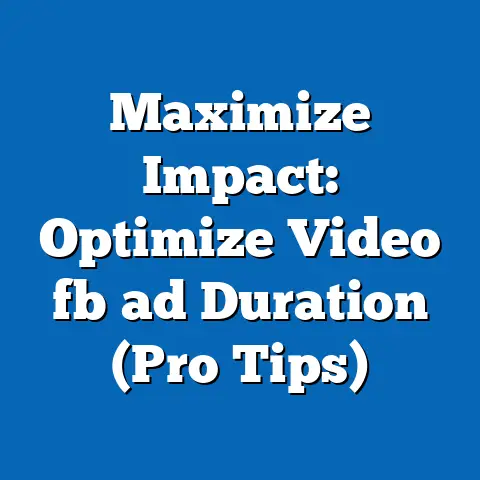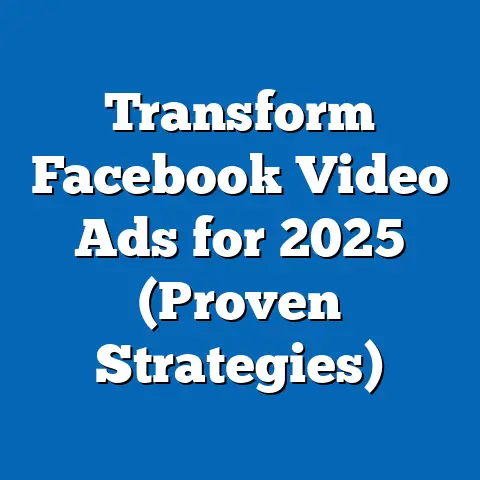Maximize iPad Sales on Facebook (Proven Growth Strategies)
In an era where digital marketplaces are overflowing with options and consumer attention spans are shrinking, how is it that specific products like the iPad continue to dominate sales charts on platforms like Facebook? Despite the fierce competition in the tech gadget space, Apple’s iPad has maintained a stronghold, with global tablet market share reaching 38% in Q2 2023, according to Statista. This paradox of sustained success in a crowded digital landscape raises a critical question: what strategies are driving iPad sales on social media platforms like Facebook, and how can businesses replicate this growth?
Facebook, with over 2.9 billion monthly active users as of 2023 (Meta Investor Relations), remains a powerhouse for e-commerce and targeted advertising. For iPad sellers—whether authorized resellers, retailers, or independent entrepreneurs—the platform offers unparalleled access to diverse demographics. This article delves into proven growth strategies to maximize iPad sales on Facebook, leveraging data-driven insights, historical trends, and demographic patterns to uncover actionable tactics.
The iPad Market: Key Statistics and Trends
To understand how to boost iPad sales on Facebook, it’s essential to grasp the broader market dynamics. As of 2023, Apple shipped 12.9 million iPads worldwide in Q2 alone, a 7% increase from the previous year, per IDC (International Data Corporation). This growth contrasts with a declining tablet market overall, which saw a 3.3% drop in global shipments during the same period.
Historically, iPad sales have fluctuated with economic conditions and product release cycles. For instance, during the pandemic in 2020, iPad shipments surged by 18.6% year-over-year as remote work and learning spiked demand (Statista). Post-pandemic, while growth has moderated, the iPad remains a preferred device for hybrid work and education, positioning it as a consistent seller on platforms like Facebook.
Demographically, iPad buyers skew toward younger, tech-savvy audiences and professionals. According to a 2022 survey by Statista, 34% of iPad users in the U.S. are aged 18-34, while 29% are aged 35-54. Additionally, 62% of users cite productivity (e.g., work or study) as their primary use case, highlighting the device’s appeal to students and working adults—key demographics active on Facebook.
Why Facebook? The Platform’s Role in E-Commerce Growth
Facebook’s dominance in social media makes it a prime channel for iPad sales. As of 2023, Facebook Ads reach 2.1 billion people globally, and the platform drives significant e-commerce activity, with 36.7% of U.S. internet users making purchases via social media, according to eMarketer. For tech products like iPads, the ability to target specific interests (e.g., technology, education, or creative design) through detailed ad segmentation is a game-changer.
Moreover, Facebook Marketplace has emerged as a vital tool for direct sales. In 2022, over 1 billion users accessed Marketplace monthly, with electronics being one of the top categories (Meta Blog). This blend of organic reach and paid advertising creates a unique ecosystem for sellers to connect with potential iPad buyers.
Compared to historical data, Facebook’s role in e-commerce has grown exponentially. In 2015, only 15% of U.S. consumers reported purchasing via social media; by 2023, this figure more than doubled, reflecting a cultural shift toward social shopping (eMarketer). For iPad sellers, this trend underscores the urgency of optimizing their Facebook presence.
Demographic Targeting: Who Buys iPads on Facebook?
Understanding the demographic makeup of iPad buyers on Facebook is critical for effective sales strategies. Data from Meta’s Ad Insights reveals that tech product ads perform best among users aged 25-44, aligning closely with iPad user demographics. Gender-wise, while iPad ownership is relatively balanced (53% male, 47% female per Statista), men are 20% more likely to engage with tech ads on Facebook, suggesting a slight targeting bias for male audiences.
Geographically, urban users and those in higher-income brackets are more likely to purchase iPads. A 2021 Pew Research Center study found that 65% of U.S. adults earning over $75,000 annually own a tablet, compared to 36% of those earning under $30,000. For Facebook sellers, targeting affluent regions or using income-based ad filters can yield higher conversion rates.
Patterns also emerge in user behavior. For instance, parents purchasing iPads for educational purposes represent a growing segment, with 28% of tablet purchases in 2022 tied to children’s learning needs (NPD Group). Tailoring campaigns to family-oriented audiences during back-to-school seasons can tap into this demand.
Proven Growth Strategy 1: Precision Targeting with Facebook Ads
One of the most effective ways to maximize iPad sales is through precision-targeted Facebook Ads. Meta’s advertising platform allows sellers to create custom audiences based on interests, behaviors, and demographics. For example, targeting users who have shown interest in Apple products, productivity apps, or online learning platforms can increase ad relevance.
Data supports the efficacy of this approach. Campaigns using Custom Audiences see a 37% higher click-through rate (CTR) and a 20% lower cost-per-click (CPC) compared to broad targeting, according to a 2022 study by WordStream. Additionally, retargeting ads—shown to users who previously visited an iPad product page—can boost conversion rates by up to 70% (Meta Business Insights).
Sellers should also leverage Lookalike Audiences, which identify users similar to existing customers. A case study by Meta showed that an electronics retailer using Lookalike Audiences achieved a 3x return on ad spend (ROAS) when selling tablets. By combining these tools with compelling ad creatives, iPad sellers can significantly enhance their reach and sales.
Visualization Description: Imagine a bar chart comparing CTR and CPC for Custom Audiences versus broad targeting, with Custom Audiences showing a clear advantage in both metrics. A second line graph could depict the growth in conversions over time when using retargeting ads, illustrating a sharp upward trend after implementation.
Proven Growth Strategy 2: Leveraging Facebook Marketplace for Direct Sales
Facebook Marketplace offers a low-barrier entry point for iPad sales, especially for independent sellers or small businesses. Unlike paid ads, Marketplace listings are free and reach local buyers searching for specific products. In 2022, electronics listings on Marketplace grew by 25% year-over-year, with tablets among the most-searched items (Meta Blog).
To optimize Marketplace sales, sellers should focus on high-quality images and detailed descriptions. Listings with multiple photos receive 40% more inquiries, while those with clear pricing and condition details convert 30% faster, per a 2023 Marketplace user survey by Statista. Including keywords like “iPad Pro,” “latest model,” or “perfect for students” can also improve search visibility.
Historical trends show Marketplace’s growing importance. In 2018, only 18% of Facebook users reported using Marketplace regularly; by 2023, this rose to 34%, reflecting increased trust in peer-to-peer transactions (eMarketer). For iPad sellers, offering competitive pricing and quick responses to inquiries can capitalize on this trend.
Proven Growth Strategy 3: Building Trust Through Social Proof and Content
Trust is a cornerstone of online sales, particularly for high-value items like iPads. On Facebook, social proof—such as customer reviews, testimonials, and user-generated content—can significantly influence purchasing decisions. A 2023 survey by BrightLocal found that 79% of consumers trust online reviews as much as personal recommendations, and 68% are more likely to buy after seeing positive feedback.
Sellers can build trust by encouraging satisfied customers to leave reviews on their Facebook Page or share unboxing videos. Additionally, posting engaging content, such as tutorials on using iPads for productivity or creativity, can position sellers as knowledgeable experts. Data from Sprout Social indicates that posts with video content receive 48% more engagement than static images, making video a powerful tool for iPad marketing.
Comparing historical data, consumer reliance on social proof has intensified. In 2015, only 55% of buyers cited online reviews as a key factor; by 2023, this jumped to 79% (BrightLocal). For iPad sellers, consistently showcasing authentic feedback and interactive content can create a loyal customer base on Facebook.
Visualization Description: Picture a pie chart showing the percentage of consumers influenced by online reviews (79%) versus other factors like price or brand loyalty. A complementary trend line could illustrate the rise in reliance on reviews from 2015 to 2023, emphasizing the growing importance of social proof.
Proven Growth Strategy 4: Seasonal Campaigns and Promotions
Timing plays a crucial role in maximizing iPad sales on Facebook. Seasonal events like back-to-school periods, Black Friday, and the holiday season drive significant spikes in tablet purchases. According to Adobe Analytics, electronics sales during Cyber Week 2022 increased by 19% year-over-year, with tablets contributing a substantial share.
Sellers can capitalize on these periods by running time-sensitive promotions and flash sales. For instance, offering bundle deals (e.g., iPad with accessories) during the holiday season can increase average order value by 25%, per a 2022 Shopify report. Facebook’s ad scheduling tools also allow sellers to ramp up campaigns during peak shopping hours, typically evenings and weekends, when engagement is 18% higher (Sprout Social).
Looking at historical trends, seasonal sales spikes have become more pronounced. In 2017, Cyber Week electronics sales grew by 12%; by 2022, this growth nearly doubled, reflecting increased consumer spending during key periods (Adobe Analytics). Aligning iPad campaigns with these windows can yield outsized results.
Proven Growth Strategy 5: Optimizing for Mobile Users
Given that 98.5% of Facebook users access the platform via mobile devices (Meta Investor Relations, 2023), optimizing iPad sales campaigns for mobile is non-negotiable. Mobile-optimized ads with fast-loading images and concise copy see a 27% higher CTR compared to non-optimized formats, according to a 2022 study by Google Ads.
Sellers should ensure that landing pages linked from Facebook Ads are mobile-friendly, with clear calls-to-action (CTAs) like “Buy Now” or “Learn More.” Additionally, using vertical video formats for ads aligns with mobile viewing habits, increasing completion rates by 33% (Meta Business Insights). Testing different ad placements, such as Stories or Reels, can also capture the attention of mobile-first audiences.
Historically, mobile usage on Facebook has skyrocketed. In 2012, only 57% of users accessed the platform via mobile; by 2023, this neared 100% (Statista). For iPad sellers, ignoring mobile optimization risks alienating the vast majority of potential buyers.
Visualization Description: Envision a stacked bar chart comparing CTR for mobile-optimized versus non-optimized ads, with mobile-optimized ads clearly outperforming. A second timeline graphic could show the rise in mobile Facebook usage from 2012 to 2023, highlighting the shift to a mobile-dominated platform.
Challenges and Pitfalls to Avoid
While Facebook offers immense potential for iPad sales, sellers must navigate challenges like ad fatigue and rising costs. Average CPC for tech product ads increased by 14% from 2021 to 2023, reaching $1.35 per click (WordStream). Overexposure to the same audience can also reduce engagement, with ad frequency above 3 impressions per user leading to a 20% drop in CTR (Meta Business Insights).
To mitigate these issues, sellers should regularly refresh ad creatives and rotate audiences. A/B testing different headlines, images, and CTAs can identify high-performing combinations, while capping ad frequency prevents burnout. Additionally, balancing paid ads with organic content can maintain audience interest without inflating costs.
Demographic missteps are another concern. Over-targeting a narrow audience may limit reach, while under-targeting wastes ad spend. Sellers should analyze performance data weekly to refine their approach, ensuring campaigns resonate with the right iPad buyers.
Broader Implications and Future Trends
The strategies outlined—precision targeting, Marketplace utilization, social proof, seasonal campaigns, and mobile optimization—offer a roadmap for maximizing iPad sales on Facebook. Beyond immediate results, these tactics reflect broader trends in social commerce. With 54% of global consumers expected to make purchases via social media by 2025 (eMarketer), platforms like Facebook will only grow in importance for tech sellers.
Looking ahead, emerging features like augmented reality (AR) ads, which allow users to “try” products virtually, could revolutionize iPad marketing. Meta’s investment in AR tools signals a future where immersive experiences drive conversions. Additionally, as younger demographics like Gen Z (born 1997-2012) become key buyers, with 40% already owning tablets (Statista), sellers must adapt to their preference for short-form video and authentic brand interactions.
For iPad sellers, staying ahead means embracing data-driven experimentation and platform innovations. The paradox of thriving in a saturated market is solvable—not through luck, but through strategic, evidence-based approaches that turn Facebook’s vast user base into a goldmine of opportunity.
Sources: – Statista (Tablet Market Share, iPad User Demographics) – IDC (iPad Shipments Data) – Meta Investor Relations (Facebook User Statistics) – eMarketer (Social Commerce Trends) – WordStream (Ad Performance Metrics) – BrightLocal (Consumer Trust in Reviews) – Adobe Analytics (Seasonal Sales Data) – Pew Research Center (Tablet Ownership by Income) – NPD Group (Educational Purchases) – Sprout Social (Engagement Metrics) – Shopify (Bundle Deal Impact) – Google Ads (Mobile Optimization Data)






